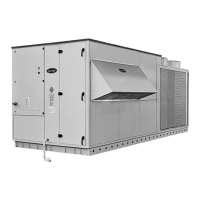This accessory is used to improve unit installation and
facilitate vertical connection of the air discharge and return
ducts. Please refer to roofcurb installation instructions for
further information.
Á¿ƖʾƘÇǾ»Íʺ
Vertical
discharge
roof curb
Air outlet
Air inlet
Roof slab
Unit
ʾ˂ƙ
Air conditioning equipment must be maintained by profes-
sional technicians, whilst routine checks can be carried out
locally by specialised technicians.
All refrigerant charging, removal and draining operations
MUSTBECARRIEDOUTBYAQUALIlEDTECHNICIANANDWITHTHE
correct material for the unit. Any inappropriate handling
CANLEADTOUNCONTROLLEDmUIDORPRESSURELEAKS
WARNING: Before doing any work on the machine ensure
that the power is switched off. If a refrigerant circuit is
opened, it must be evacuated, recharged and tested for
leaks. Before any operation on a refrigerant circuit, it is
necessary to remove the complete refrigerant charge from
the unit with a refrigerant charge recovery group.
In order to obtain maximum performance from the unit
special attention should be paid to the following points:
s %LECTRICALCONNECTIONSThe supply voltage should be
within the limits permitted by the compressor.
Ensure that no faulty contacts exist in the terminal
blocks, contactor boards, etc. Make sure that all the
electrical connections are properly tightened, and that
all the electrical components (contactors, relays, etc)
ARElRMLYSECUREDTOTHECORRESPONDINGRAILS
Pay special attention to the condition of the connecting
cables between the control elements and the control box,
and to that of the unit power supply cable. Check the
starting and running consumptions are within the limits
SPECIlEDINTHECORRESPONDINGTECHNICALINFORMATION
s $RAINAGE Frequently check that the drain is not
obstructed, and that the condensate pan is clean and
level.
s )NLETlLTERThis should be cleaned periodically. The
frequency depends on the purity of the entering air.
4HEDIRTYlLTEROPTIONCANBEUSEDTOlNDOUTWHEN
THElLTERNEEDSTOBECHANGED!SETOFlLTERSCANBE
ordered as a spare part.
s 2EFRIGERANTCIRCUIT Ensure that there is no leakage of
refrigerant or oil from the compressor. Check that the
high and low side operating pressures are normal. Make
sure that the coils are not dirty. Check for unusual
compressor noise.
s #ONTROLSCheck the operation of all relays, high and
low pressure transducers and the high-pressure switch,
etc. Use the quick test function of the Touch Pilot
control.
ʾ˂ƖʾƘ¹ÁÆ̽ƹƻ½ÈÊǿʹÅŽ
All maintenance operations must be carried out by techni-
cians who have been trained on Carrier products, observing
all Carrier quality and safety standards.
ʾ˂ƖʿƘ¹ÁÆ̽ƹƻ½ÁÆËÌÊÍ»ÌÁÇÆË
During the unit operating life the service checks and tests
must be carried out in accordance with applicable national
regulations.
If there are no similar criteria in local regulations, the infor-
mation on checks during operation in annex C of standard
EN 378-2 can be used.
External visual checks: annex A and B of standard EN 378-2.
Corrosion checks: annex D of standard EN 378-2. These
controls must be carried out:
s !FTERANINTERVENTIONTHATISLIKELYTOAFFECTTHERESIS
tance or a change in use or change of high-pressure
refrigerant, or after a shut down of more than two years.
Components that do not comply, must be changed.
Test pressures above the respective component design
pressure must not be applied (annex B and D).
s !FTERREPAIRORSIGNIlCANTMODIlCATIONSORSIGNIlCANT
system or component extension (annex B)
s !FTERREINSTALLATIONATANOTHERSITEANNEXES!"AND
D)
s !FTERREPAIRFOLLOWINGAREFRIGERANTLEAKANNEX$
The frequency of refrigerant leak detection can vary
from once per year for systems with less than 1% leak
rate per year to once a day for systems with a leak rate
of 35% per year or more. The frequency is in proportion
with the leak rate.
NOTE: High leak rates are not acceptable. The necessary
steps must be taken to eliminate any leak detected.
./4%&IXEDREFRIGERANTDETECTORSARENOTLEAKDETECTORS
as they cannot locate the leak.
52

